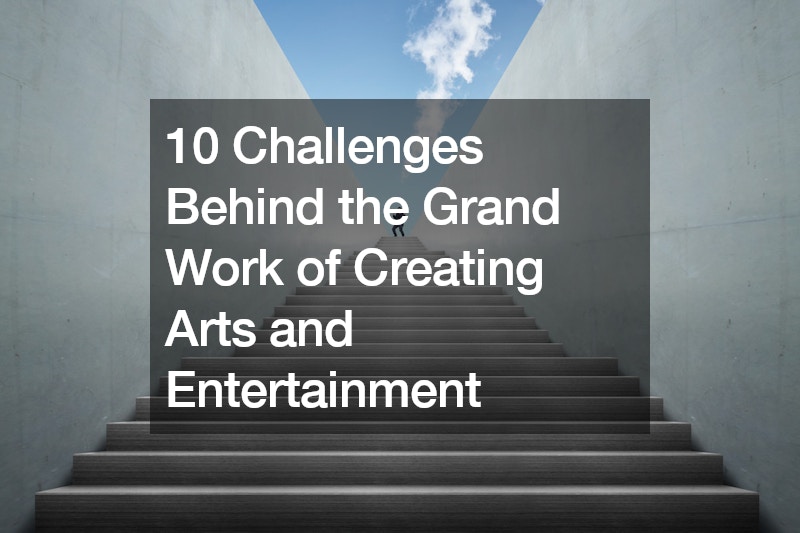
Arts and entertainment is a growing industry that plays an important societal role. It encompasses various forms of creative expression, such as music, visual arts, performing arts, literature, and more. Arts and entertainment have been a part of human culture for centuries, with evidence of artistic expression found in ancient civilizations.
The importance of the arts has continued to grow over time, reflecting changes in technology and culture. However, everyone knows the grand work that comes with the end of every masterpiece. That’s why it’s important to know that the challenges of creating art, whether in the entertainment industry or any other creative field, should not discourage individuals from pursuing their passion.
The Challenges Behind The Grand Work of Arts And Entertainment
Arts and entertainment are grand works that require endless hours of practice, dedication, and hard work. It’s not just about being naturally talented but also having the drive to continuously improve and adapt. With so many individuals pursuing their passion in this industry, competition is fierce and can be overwhelming for new artists. Here are some of the most common challenges known to people in the industry.
1. Dealing With Demanding Logistics

Securing suitable venues for performances or exhibitions is often a Herculean task for artists and entertainers. The logistics involved in orchestrating an event, be it a gallery showing or a music concert, can be a grand work as the creation of the artwork itself. Venues often come with a high cost, requiring a substantial investment before an artist can showcase their project to the public. Furthermore, the competition for prime locations can be fierce, especially in metropolitan areas with premium space.
Artists must often book months in advance, coordinate with event planners, and ensure their work fits within the venue’s physical constraints and aesthetic. This challenge is a testament to the multifaceted nature of the arts and entertainment industry — it’s not only about talent but also about strategic planning and the ability to navigate the complexities of event management.
2. Searching for Perfect Props
For artists, finding the perfect props for a performance or an exhibition can be as demanding as creating the grand work itself. Props are not just mere accessories; they hold the power to enhance the aesthetic appeal of the presentation and contribute to the storytelling process. This search can often become an exhaustive scavenger hunt for items like bar stools that fit a production’s precise visual and functional requirements.
These props must not only match the period and style of the piece but also withstand the rigors of performances and the audience’s scrutiny. A vintage bar stool could be a central piece in a period drama, while modern, sleek bar stools may set the scene in a contemporary play. Sourcing these items typically involves visiting antique shops, browsing online vendors, or even designing and creating the props from scratch to ensure each item resonates with the grand work’s overarching theme and setting. The journey to procure just the right props can be unpredictable and time-consuming, but when done right, it significantly contributes to the authenticity and depth of the artistic experience.
3. Achieving Difficult Camera Angles
Film and photography are the art of capturing images, but the power behind a truly compelling visual often lies in the camera angle. Achieving the right angle is critical to the storytelling process, as it can influence the audience’s perspective and emotional response to the scene. For instance, a car chase scene might require a dynamic ‘car cam‘ setup to immerse viewers in the high-speed action, thereby heightening the intensity and excitement of the chase. This can involve using specialized rigs that securely attach cameras to vehicles, capturing the rush and danger from unique viewpoints.
In pursuing a grand work, cinematographers and directors go to great lengths to depict their vision with accuracy and creativity. Nailing the perfect camera angle may involve complex rigging, innovative technology, and an understanding of the physics involved in moving both the camera and the subject. Whether securing a camera to the hood of a car for a low-angle shot or employing drones for aerial views, the goal remains the same: to tell a visual story that resonates with audiences. These challenging camera angles are not simply aesthetic choices; they’re narrative tools that serve the project, amplifying its impact and leaving a lasting impression on the viewer.
4. Marketing for Success

Transforming a project from a creative concept into a cultural phenomenon requires artistic talent and strategic marketing. A marketing agency is pivotal, serving as the conduit between artists and their audiences. Effective marketing campaigns can elevate a project, ensuring that the target demographic is not only reached but also captivated. It does so by crafting a narrative around the project that resonates with potential consumers, utilizing a mix of traditional and digital media platforms to generate buzz and anticipation.
In a world saturated with content, a marketing agency must operate with precision and innovation to cut through the noise and position a grand work for success. Whether it’s a film, a music album, or a new technology product, how it’s marketed can be just as critical as the quality of the work itself. The agency’s mission is to create a connection beyond a mere transaction, building a loyal fanbase and fostering a community around the work. By integrating market research, brand strategy, and creative storytelling, the agency strives to leave an indelible mark on the cultural landscape, turning grand works into lasting legacies.
5. Shooting on Location
When it comes to bringing a project to life, the choice of location is a fundamental element that shapes the authenticity and ambiance of the project. Shooting on location allows for an organic integration of the setting with the narrative, embedding a genuine sense of place that cannot be replicated on a soundstage. For instance, a picturesque farm exudes a rustic charm that is essential for certain storytelling genres, while farm and tractor supply elements can provide a degree of realism to scenes that demand agricultural authenticity. Filming on location, amidst natural landscapes, or within the bustle of urban life, infuses the work with an unfiltered character that resonates with audiences.
Producers and directors often seek out unique locales that suit the screenplay and enhance the cinematography, becoming a character of their own within the project. The benefits, however, are accompanied by logistical complexities. Obtaining permits, managing weather changes, and ensuring the availability of nearby tractor supply stores for unforeseen production needs are just a few of the hurdles. Despite these challenges, the tactile experience of a real-world environment enriches the grand work, potentially elevating it from just another story to a landmark in visual storytelling that viewers cherish and remember.
6. Working With Animals
In cinematic productions, animals can bring an immeasurable depth to storytelling, their unscripted nature contributing subtle nuances that enrich the grand work. When directors interweave animal characters into the narrative, such as through dog walking scenes, they tap into a vein of visual storytelling that can evoke strong emotional responses from viewers. This connection mirrors our experiences in life, where animals often play significant roles. However, integrating animals into a production demands a comprehensive understanding of animal behavior, welfare considerations, and strict compliance with regulations and safety protocols.
For example, a dog walking scene requires detailed planning, from selecting the breed that fits the storyline to hiring skilled animal handlers. While it might seem simple, capturing the essence of the relationship between the dog and its owner on screen is grand work. Achieving authentic interactions that propel the narrative requires a delicate balance of control and spontaneity. Moreover, production must ensure that the animal’s welfare is paramount, which involves maintaining humane conditions on set and providing appropriate rest and care to service animals.
7. Finding Storage Space

Ensuring that valuable equipment, props, and set pieces remain undamaged during production and transport requires more than ordinary storage solutions — it necessitates custom wood crates, specially designed to protect these crucial assets. Crates are pivotal in this industry, crafted specifically to dimensions and specifications that safeguard the contents against the rigors of transit and storage conditions. They provide a reliable protective cocoon for delicate and expensive items and optimize space, allowing for an organized, efficient, and secure storage system capable of housing an array of materials, from the most rugged to the most fragile.
Besides their functional purpose, custom wood crates resonate with the ethos of grand work. They exemplify meticulous craftsmanship and attention to detail, qualities that mirror the dedication and precision inherent in all aspects of cinematic production. The designing and construction of these crates, much like the filmmaking process itself, blend artistry with functionality to facilitate the seamless execution of a project. Proper storage solutions, thus, are more than just a practical necessity; they embody the reverence with which every element of production, no matter how seemingly insignificant, is treated.
8. Balancing Artistic Vision and Practicality
The interplay between artistic vision and practicality becomes paramount in a photography studio, where every shot aims to capture an ethereal moment or convey a compelling story. The work conducted within these creative spaces is a testament to the photographer’s ability to harmonize their imaginative scope with the tangible, often limiting, aspects of the physical environment.
Mastery of light, composition, and scene setting — while navigating the constraints of space, budget, and resources — marks the difference between a mere photo and a transformative visual experience. Such a balancing act demands a deep understanding of one’s craft and an unwavering commitment to artistic integrity, ensuring every photograph is seen and truly felt by its beholder. The photography studio thus becomes an arena where work is actualized, bringing artistic visions to life against the grain of everyday practicalities.
9. Managing Waste
In trash collection, efficiency, and sustainability are key elements that contribute to a healthier environment and smarter management of resources. Effective waste management systems are critical in minimizing the environmental impact of both residential and industrial activities. By implementing strategic collection protocols, communities can drastically reduce the unwanted spillover of refuse into natural habitats, waterways, and urban areas.
The process is about removing waste and adhering to responsible disposal practices that respect ecological boundaries. This thoughtful approach to the collection can lead to innovative recycling initiatives and waste-to-energy projects, illustrating a commitment to environmental stewardship and resource conservation, especially in the arts and entertainment industry. With the planet facing increasing waste challenges, handling trash collection with diligence and foresight becomes ever more crucial, ensuring we leave a minimal footprint on the earth’s delicate ecosystems.
10. Creating Convincing Sets

Creating convincing sets is an exercise in transformation, where custom home builders employ their expertise to alter spaces into grand works of artistry that capture the essence of the narrative. Employing the skills of builders who specialize in custom homes ensures that even the smallest architectural details are tailored to reinforce the story being told, whether it’s a period drama set in the Victorian era or a futuristic sci-fi adventure. These craftsmen draw upon a vast repertoire of design and construction techniques to fabricate environments that are not only visually mesmerizing but also structurally sound, providing the necessary backdrop for immersive storytelling.
To achieve such grand work, it’s not merely about the aesthetics but also the believability and functionality that allow actors to navigate and interact with their surroundings convincingly. These custom-built spaces must be adaptable to the dynamic needs of a production, from acoustics for sound recording to the rigging for lighting and equipment. The compelling authenticity of a set can make or break the audience’s suspension of disbelief, and therefore, the partnership between custom home builders and artistic directors is pivotal. They collaboratively ensure that every nail, paint stroke, and prop placement contributes to an authentic transporting experience for the performers and the viewers alike.
The arts and entertainment industry relies heavily on the expertise and creativity of professionals to bring their visions to life. Through intricate design and careful attention to detail, these professionals transform spaces into captivating settings that enhance the storytelling experience for both performers and audiences. The use of customized idealistic environments and believability to productions elevates them from mere performances to truly immersive experiences, further adding to the art of every frame.



